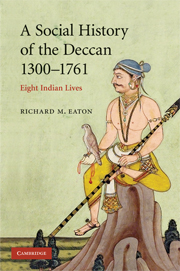Book contents
- Frontmatter
- Introduction
- 1 Pratapa Rudra (R. 1289–1323): the demise of the regional kingdom
- 2 Muhammad Gisu Daraz (1321–1422): Muslim piety and state authority
- 3 Mahmud Gawan (1411–1481): Deccanis and Westerners
- 4 Rama Raya (1484–1565): élite mobility in a Persianized world
- 5 Malik Ambar (1548–1626): the rise and fall of military slavery
- 6 Tukaram (1608–1649): non-brahmin religious movements
- 7 Papadu (fl. 1695–1710): social banditry in Mughal Telangana
- 8 Tarabai (1675–1761): the rise of Brahmins in politics
- Select bibliography
- Index
- Plate Section"
- References
Select bibliography
Published online by Cambridge University Press: 28 March 2008
- Frontmatter
- Introduction
- 1 Pratapa Rudra (R. 1289–1323): the demise of the regional kingdom
- 2 Muhammad Gisu Daraz (1321–1422): Muslim piety and state authority
- 3 Mahmud Gawan (1411–1481): Deccanis and Westerners
- 4 Rama Raya (1484–1565): élite mobility in a Persianized world
- 5 Malik Ambar (1548–1626): the rise and fall of military slavery
- 6 Tukaram (1608–1649): non-brahmin religious movements
- 7 Papadu (fl. 1695–1710): social banditry in Mughal Telangana
- 8 Tarabai (1675–1761): the rise of Brahmins in politics
- Select bibliography
- Index
- Plate Section"
- References
- Type
- Chapter
- Information
- A Social History of the Deccan, 1300–1761Eight Indian Lives, pp. 203 - 209Publisher: Cambridge University PressPrint publication year: 2005



